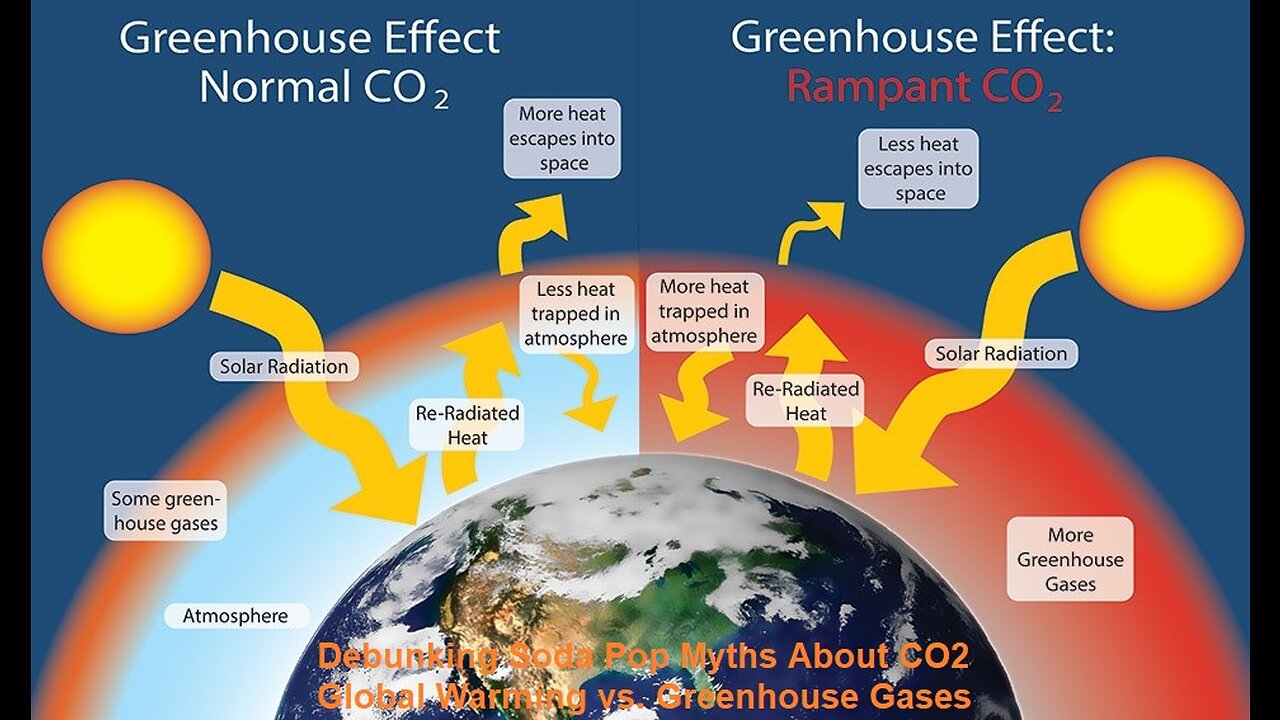Premium Only Content

Debunking Soda Pop Gases Myths Pt.1 About CO2 Global Warming vs. Greenhouse Gases
Since increasing carbon dioxide in the atmosphere is causing global warming, then why the continued manufacture of Carbon Dioxide Fire Extinguisher and Carbonated Soft Drinks? Climate change deniers make many false claims about carbon dioxide and other greenhouse gases. These include the idea that CO2 has a limited or negligible impact on global warming—or even has the net effect of cooling our planet. Some also claim that the greenhouse effect would violate the laws of physics. Others make the assertion that the small quantities of greenhouse gases in the atmosphere couldn't possibly cause significant worldwide temperature changes. As I show here, every single one of these arguments are incorrect.
Assume the average American drinks 50 gallons of carbonated soft drinks each year and the U.S. population is 328 million people. That means about 16.4 billion gallons of soda is consumed every year in the United States. One gallon equals 3.78 liters, so U.S. annual consumption of carbonated soft drinks is 63 billion liters. Total annual carbon dioxide emissions is about 27.4 billion metric tons. Thus, 0.001 percent of all carbon dioxide emissions in the United States is contributed by carbonated soft drinks. These numbers are only rough approximations, but the inescapable conclusion is that carbon dioxide released into the atmosphere from soft drinks is inconsequential.
When Would It Be Dangerous to Use a Carbon Dioxide Fire Extinguisher?
Carbon dioxide fire extinguishers, when used in the right circumstances can save lives. However, it would be dangerous to use a carbon dioxide fire extinguisher when dealing with flammable gases, cooking oils and fats, or in a confined space.
The terms global warming and climate change are often used interchangeably, but the two phenomena are different.
Global warming is the rise in global mean temperature due to the rampant release of heat trapping gasses like carbon dioxide and methane (see figure below). The atmosphere acts like a blanket that surrounds the earth. When we burn oil, coal, or natural gas for energy, the carbon dioxide released acts like thickening the blanket that envelops our planet. This disrupts the balance of incoming and outgoing solar radiation, and creates a warming system that cannot naturally repair itself in the span of the coming centuries. Based on surface and atmospheric temperatures from thousands of locations, and from satellites worldwide, scientists have determined that the global mean temperature has risen 0.8 degrees C (1.4 degrees F) since 1880. We know the carbon dioxide released from the fossil fuels that humans are burning is responsible for this change because its unique chemical signature matches that found in the carbon dioxide entering our atmosphere right now.
Climate change is a more general term that refers to changes in many climatic factors (such as temperature and precipitation) from the global to the local scale. These changes are happening at different rates and in different ways in response to global warming. As a large scale example, the United States has overall become wetter over the 20th century, while the Sahel region of central Africa has become drier. Locally, the timing and amount of rainfall is changing, which is generally resulting in less frequent but more severe storms. This could lead to increased hillside erosion and flooding, even as overall aridity continues to intensify in some areas. Furthermore, global warming and associated climate change is decreasing the Sierra snow pack and melting it sooner, causing water shortages across the state and increasing wildfire risk. In other words, the climate is becoming more extreme in response to global warming.
(Part One Words and Type Part Two Next Video)
Why Global Warming Would be Good for You ? Or Is Global Warming A Boon to Humans and Other Animals ?
Senator Mitchell's forecast and his history are both wrong. Warmer periods bring benign rather than more violent weather. Milder temperatures will induce more evaporation from oceans and thus more rainfall -- where it will fall we cannot be sure but the earth as a whole should receive greater precipitation. Meteorologists now believe that any rise in sea levels over the next century will be at most a foot or more, not twenty. In addition, Mitchell flunks history: around 6,000 years ago the earth sustained temperatures that were probably more than four degrees Fahrenheit hotter than those of the twentieth century, yet mankind flourished. The Sahara desert bloomed with plants, and water loving animals such as hippopotamuses wallowed in rivers and lakes. Dense forests carpeted Europe from the Alps to Scandinavia. The Midwest of the United States was somewhat drier than it is today, similar to contemporary western Kansas or eastern Colorado; but Canada enjoyed a warmer climate and more rainfall.
Raising the specter of disaster as well, Vice President Al Gore has called the threat of global warming "the most serious problem our civilization faces." In fact, he has styled those who dispute it as "self-interested" and compared them to spokesmen for the tobacco industry who have questioned the relation of smoking to cancer. But Gore is misinformed; many disinterested scientists, including climatologists with no financial interest other than preventing wasteful expenditures of society's limited resources, question the evidence and the models that underlie the warming hypothesis.
In fact, the evidence supporting the claim that the earth has grown warmer is shaky; the theory is weak; and the models on which the conclusions are based cannot even replicate the current climate. It is asserted, for example, that over the last hundred years the average temperature at the earth's surface has gone up by 0.5deg. Centigrade or about 1deg. Fahrenheit. Given the paucity of data in the Southern Hemisphere, the evidence that in the United States, with the best records, temperatures have failed to rise; the British naval records that find no significant change in temperatures at sea since the mid-1800s; and that the reported increases occurred mainly prior to 1940 -- before the rapid rise in CO2 -- the public is entitled to be wary. Moreover, even the National Academy of Sciences is skeptical of the validity of the computer models and warns that the modeling of clouds -- a key factor -- is inadequate and poorly understood.
The dire forecasts of global warming hinge on a prediction that human activity will provoke a continued upsurge in atmospheric carbon dioxide. Many environmentalists believe that the burning of fossil fuels, the release of methane from agricultural activities, and the escape of other chemicals into the air over the next few decades will lead to an effective doubling of greenhouse gases sometime in the next century. Although fluctuations in CO2 correlate with climate shifts, the record cannot distinguish whether they followed the temperature changes or preceded them. Theory suggests either is possible.
What is well known is that climate changes. The world has shifted from periods that were considerably warmer -- during the Mesozoic era when the dinosaurs thrived the earth appears to have been about 18deg. Fahrenheit warmer than now -- to spells that were substantially colder, such as the Ice Ages when huge glaciers submerged much of the Northern Hemisphere. One paleo climatologist estimated that, during the Precambrian period, the polar regions were about 36deg.F colder than they are in the contemporary world. During the last interglacial, about 130,000 years ago or about when modern man was first exploring the globe, the average temperature in Europe was at least 2deg. to 5deg.F warmer than at present. Hippopotamuses, lions, rhinoceroses and elephants roamed the English countryside. Areas watered today by the monsoons in Africa and east Asia enjoyed even more rainfall then. Indeed during the last 12,000 years, that is since the end of the last glacial period, the globe has alternated between times substantially warmer and epochs that were noticeably cooler.
An examination of the record of the last twelve millennia reveals that mankind prospered during the warm periods and suffered during the cold ones. Transitions from a warm to a cold period or vice-versa were difficult for people who lived in climates that were adversely affected yet benefited others who inhabited regions in which the weather improved. On average, however, humans gained during the centuries in which the earth enjoyed higher temperatures. In writing about the effect of climate change on human development, Senator and now Vice-President Al Gore admits:
The archaeological and anthropological records indicate that each time the ice retreated [during the ice ages], the primitive peoples of the Eurasian landmass grew more populous and their culture more advanced. ... Then, 40,000 years ago, the so-called cultural explosion of tools and jewelry may have coincided with an unusually warm millennium in Europe.
Expected Effects of Global Warming
Although most of the forecasts of global warming's repercussions have been dire, an examination of the likely effects suggests little basis for that gloomy view. Climate affects principally agriculture, forestry, and fishing. Manufacturing, most service industries, and nearly all extractive industries are immune to climate shifts. Factories can be built in northern Sweden or Canada or in Texas, Central America, or Mexico. Banking, insurance, medical services, retailing, education and a wide variety of other services can prosper as well in warm climates (with air-conditioning) as in cold (with central heating). A few services, such as transportation and tourism, may be more susceptible to weather. A warmer climate will lower transportation costs: less snow and ice will torment truckers and automobile drivers; fewer winter storms -- bad weather in the summer has less disruptive effects and is over quickly -- will disrupt air travel; a lower incidence of storms and less fog will make water transport less risky. Hotter temperatures will leave mining and the extractive industries largely unaffected; they might even benefit oil drilling in the northern seas and mining in the mountains. A warmer climate could, however, change the nature and location of tourism. Many ski resorts, for example, might face less reliably cold weather and shorter seasons. Warmer conditions would mean that fewer northerners would feel the need to vacation in Florida or the Caribbean. On the other hand, new tourist opportunities might develop in Alaska, northern Canada and other locales at higher latitudes or in upper elevations.
A rise in world-wide temperatures will go virtually unnoticed by inhabitants of the advanced industrial countries. In his 1991 address to its members, the President of the American Economic Association asserted: "I conclude that in the United States, and probably Japan, Western Europe and other developed countries, the impact on economic output [of global warming] will be negligible and unlikely to be noticed." As modern societies have developed a larger industrial base and become more service oriented, they have grown less dependent on farming, thus boosting their immunity to temperature variations. Warmer weather means, if anything, fewer power outages and less frequent interruptions of wired communications.
Only if warmer weather caused more droughts or lowered agricultural output would even Third World countries suffer. Should the world warm -- and there is little evidence or theory to support such a prognostication -- most climatologists believe that precipitation would increase. Although some areas might become drier, others would become wetter. Judging from history, Western Europe would retain plentiful rainfall, while North Africa and the Sahara might gain moisture. The Midwest of the United States might suffer from less precipitation and become more suitable for cattle grazing than farming. On the other hand, the Southwest would likely become wetter and better for crops.
A warmer climate would produce the greatest gain in temperatures at northern latitudes and much less change near the equator. Not only would this foster a longer growing season and open up new territory for farming but it would mitigate harsh weather. The contrast between the extreme cold near the poles and the warm moist atmosphere on the equator drives storms and much of the earth's climate. This difference propels air flows; if the disparity is reduced, the strength of winds driven by equatorial highs and Arctic lows will be diminished.
Warmer nighttime temperatures, particularly in the spring and fall, create longer growing seasons, which should enhance agricultural productivity. Moreover, the enrichment of the atmosphere with CO2 will fertilize plants and make for more vigorous growth. Agricultural economists studying the relationship of higher temperatures and additional CO2 to crop yields in Canada, Australia, Japan, northern Russia, Finland, and Iceland found not only that a warmer climate would push up yields, but also that the added boost from enriched CO2 would enhance output by 17 percent. Researchers have attributed a burgeoning of forests in Europe to the increased CO2 and the fertilizing effect of nitrogen oxides. Professor of Climatology Robert Pease writes that we may now be living in an "icehouse" world and that a warming of about two degrees Celsius, which is what his model indicates,
may actually make the earth more habitable. The higher temperatures combined with more carbon dioxide will favor plant and crop growth and could well provide more food for our burgeoning global populations. Geologic history reveals that warmer global temperatures produce more, not less, precipitation, a fact reflected by a recent scientific investigation that shows the Greenland ice-cap to be thickening, not melting. So much for the catastrophic prediction that our coastlines will be flooded by a rise in sea level from polar meltwaters.
The United States Department of Agriculture in a cautious report reviewed the likely influence of global warming on crop production and world food prices. The study, which assumed that farmers fail to make any adjustment to mitigate the effects of warmer, wetter, or drier weather -- such as substituting new varieties or alternative crops, increasing or decreasing irrigation -- concludes that:
The overall effect on the world and domestic economies would be small as reduced production in some areas would be balanced by gains in others, according to an economic model of the effects of climate change on world agricultural markets. The model ... estimates a slight increase in world output and a decline in commodity prices under moderate climate change conditions. [Emphasis added.]
Economists Robert Mendelsohn, William D. Nordhous, and Daigee Shaw researched the relationship of climate to land values in the United States. After holding land quality, the proximity to urban areas and the nearest coast, and income per capita constant, they found that climate explained over two-thirds of the value of crop lands. They concluded that for the lower-48 states, a rise in average temperature of about 5deg.F and an 8 percent increase in rainfall stemming from global warming would, depending on their model, reduce the value of output between 4 and 6 percent or boost the value of output slightly. This result ignored the effect of increased CO2 on farm output. It is also consistent with the Department of Agriculture study that suggests the U.S. might see a slight fall in output while the rest of the world increased production.
Forestry is another sector that is potentially subject to change due to an increase in world temperatures. Canadian agricultural economists have examined the effect of a doubling of CO2 on forestry production. They concluded that increased carbon dioxide would boost productivity by 20 percent and that overall the harvest of timber in Canada would climb by about 7.5 percent.
Historical Evidence
History provides the best evidence for the effect of climate change on humans, plants and animals, but a few researchers have challenged its relevance. David Rind, a climate modeler and NASA scientist, has questioned the applicability of past warming episodes to the modern issue of climatic alteration caused by increased CO2 concentrations. He attributes the origin of past periods of warmth and cold to shifts over time in the orbital position of the earth which impose more or less energy on the poles, as contrasted to a general world-wide warming that might result from the addition of man-made greenhouse gases. [See Appendix A on factors determining climate]. He also argues that the swiftness in warming that would occur following increased levels of CO2 is unprecedented in history. On the latter point, he ignores other research, such as that by a German academic, Burkhard Frenzel, who writes, "During the Holocene, very rapid changes of climate occurred. According to dendroclimatology [tree ring analysis applied to climatology], they often lasted about 20 to 30 years, or [were] even as brief as 2 to 3 years."[18] Other climate historians have found that a rapid cooling in the late glacial period -- about 11,000 years ago --took about 100 to 150 years to complete and realized about 5deg.F variation in temperature within 100 years, more than is being forecast for the next century.
Although changes in the earth's orbital position may easily have played a role in warming the earth after the last Ice Age, the effect was world-wide rather than concentrated in northern latitudes. Ice retreated in the Southern as well as in the Northern Hemisphere. Moreover, in the subsequent warming, from around 7,000 to 4,000 years ago, the climate around the world appears to have improved. Although the evidence for warming in the Southern Hemisphere is weaker, even if higher temperatures had been localized in one hemisphere or one continent, the effect on human beings would still tell us about the benefits or costs of climatic change. Dr. Rind argues that greenhouse warming would raise winter as well as summer temperatures while past warmings, driven by orbital mechanics, have raised summer temperatures alone. Even though his models suggest that these past warmings should have boosted temperatures solely in June, July, and August, the evidence, albeit a little tenuous for the three thousand year period of Climatic Optimum, supports warmer winters. For the Little Climate Optimum that coincided with the High Middle Ages, researchers have found strong support for mild winters.
Moreover, at a recent conference the Russians have put forward the hypothesis that past climate changes support the proposition that the cause of the warming or cooling is irrelevant; the pattern has been the same. This conclusion, disputed by some, is based on a large number of past shifts in average weather conditions dating back millions of years. The Russians contend that the climate models overstate the amount of temperature change at the equator and understate it at the poles.
Measurement of Human Well-being
Since statistics on the human condition are unavailable except for the most recent centuries, I shall use indirect methods to demonstrate the influence of climate on man's well-being. A growth in the population, major construction projects, a significant expansion in arts and culture, all indicate that society is prosperous. If the population is expanding, food must be plentiful, disease cannot be overwhelming, and living standards must be satisfactory. In addition, if building, art, science, and literature are vigorous, the civilization must be producing enough goods and services to provide a surplus available for such activities. Renaissance Florence was rich; Shakespeare flourished in prosperous London; wealthy Vienna provided a welcome venue for Haydn, Schubert, Mozart, and Beethoven.
Clearly climate is far from the only influence on man's well-being. Governments that extort too much from their people impoverish their countries. A free open economy stimulates growth and prosperity. War and diseases can prove catastrophic. On the other hand, a change in climate has frequently been a cause of war or aided the spread of disease. A shift to more arid conditions, for example, impelled the Mongols to desert their traditional lands to invade richer areas. A cold wet climate can also confine people to close quarters, which can abet contagion. Moreover, a shift towards a poorer climate can lead to hunger and famine, which make disease more virulent.
Throughout history climatic changes probably forced technological innovations and adaptations. The shift from warm periods into Ice Ages and back again likely accelerated the evolution of modern man. Each shift would have left small groups of hominoids isolated and subject to pressures to adapt to new weather conditions. These shifts, especially to the more adverse conditions created by the spread of extreme cold, would put strong selection pressure on the human forebears that ultimately led to modern man. Even after Homo Sapiens started spreading across the earth, climate shifts fostered new technologies to deal with changed circumstances.
The influence of climate on human activities has declined with the growth in wealth and resources. Primitive man and hunter-gatherer tribes were at the mercy of the weather, as are societies which are still almost totally bound to the soil. A series of bad years can be devastating. If, as was the usual case until very recently, transportation is costly and slow, even a regionalized drought or an excess of rain can lead to disaster, although crops may be plentiful a short distance away. Thus variation in the weather for early man had a more profound influence on his life and death than do fluctuations in temperature or rainfall in modern times when economies are more developed. Since the time of the Industrial Revolution, climate has basically been confined to a minor role in human activity.
Climate History
Since its origins, the earth has experienced periods significantly warmer than the modern world -- some epochs have been even hotter than the most extreme predictions of global warming -- and times much colder than today. Today's cool temperatures are well below average for the globe in its more than four billion year history. During one of the warmest such eras the dinosaurs roamed the earth and a rich ecological world flourished.
Studies of climate history show as was mentioned above that sharp changes in temperatures over brief periods of time have occurred frequently without setting into motion any disastrous feedback systems that would lead either to a runaway heating that would cook the earth or a freezing that would eliminate all life. In addition, carbon dioxide levels have varied greatly. Ice core data exhibit fluctuating levels of CO2 that do not correspond to temperature changes. Most past periods display a positive relationship between CO2 and temperature, however, with a relationship roughly corresponding to that of the Global Climate Models. During interglacial periods high latitudes enjoyed temperatures that were about 5deg. to 11deg.F warmer than today. Middle latitudes experienced temperatures only about 4deg. to 5deg.F warmer. These warmer periods brought more moisture to the Northern Hemisphere with the exception during the Holocene of central North America. At the time of the medieval warm period, temperatures in Europe, except for the area around the Caspian Sea basin, were 1deg. to 3deg.F higher and rainfall more plentiful than today.
This historical evidence is consistent with only some of the forecasts of the computer climate models. Most climate estimates indicate that a doubling of CO2 would generate greater rainfall in middle latitudes, and history shows that warm climates do produce more wet weather. As has been found in the historical record, land temperatures should increase more than water thus strengthening monsoons. The models also predict that sea-surface temperatures in the tropics would be higher with increased CO2 but evidence from the past evinces no such relationship.
Carbon dioxide concentrations may have been up to sixteen times higher about 60 million years ago without producing runaway greenhouse effects. Other periods experienced two to four times current levels of CO2 with some warming. Scientists have been unable to determine whether the warming preceded or followed the rises in carbon dioxide. For virtually all of the period from around 125 million to about 75,000 years ago, CO2 levels were markedly higher than now.
The prevailing view among climatologists is that the Climatic Optimum -- 9,000 to 4,000 years ago -- resulted from orbital mechanics which increased summer radiation in the Northern Hemisphere, although winters received less heat than they do in the modern world. The warmer summers melted the northern glaciers over several millennia. Warmer lands in the interior of northern continents and cooler oceans expanded the monsoons further north to bring greater rainfall to the Sahara, Arabia and southern and eastern Asia. North of the monsoon area, the climate was drier than today. Anatolia, Northwestern Africa, parts of China and northern Japan experienced less rainfall. By 4000 B.C., however, a slackening of the trade winds had produced warmer Atlantic ocean water off northwestern Africa, and as a consequence the Middle East, including Greece and modern Turkey, were enjoying more reliable rain.
If orbital variations produced the Climatic Optimum, the Southern Hemisphere should have been cooler. Between 10,000 B.C. and 7000 B.C., however, winter temperatures (June, July, August) below the equator warmed to higher levels than now while summer temperatures (December, January, February) were cooler than the modern world. Rainfall over South America, Australia and New Zealand apparently was lighter than the present. Although the Southern Hemisphere moved out of the Ice Age with the Northern Hemisphere, its climate since then has not tracked well weather patterns north of the equator. Data based on vegetation suggest that annual temperatures in New Zealand were coldest between 20,000 and 15,000 years ago, warmed subsequently and peaked between 10,000 and 8,000 years before the present -- somewhat earlier than they did in the Northern Hemisphere. Temperatures appear to have been falling over the last 7,500 years. By 1500 B.C., the climate was quite similar to today's.
Whether the whole globe warmed or not during the period 7,000 to 4,000 years ago is really irrelevant to the question of how hotter temperatures affect humans. If the Northern Hemisphere warmed, and there is good evidence that it did, then comparing how people survived in that portion of the globe provides information about how higher global temperatures would influence mankind.
Modern man apparently evolved into his current genotype between 40,000 and 200,000 years ago, probably in Africa during an Ice Age. Around 150,000 years ago the extent of ice coverage reached a maximum, followed around 130,000 years before the present (YBP) by a rapid deglaciation. The warm interglacial era, during which temperatures may have exceeded those forecast under a doubling of greenhouse gases, lasted about 15,000 years until the onset of renewed glaciation at 115,000 YBP. Over the next 100,000 years the glaciers fluctuated with the climate, but at no time did the average temperature equal the level of the previous interglacial epoch or reach the warmth of the last 10,000 years.
In the thousands of years of the last Ice Age preceding the current warm epoch, man existed as a hunter-gatherer in a world that looked quite different from today's. Herds of large animals such as bison, mammoths, and elk roamed a largely treeless savanna in Europe. These beasts made easy prey for human hunters that enjoyed as a consequence a rich diet of wild animal meat plus, in season, local fruits and vegetables. It was during the Ice Age that the level of the ocean fell sufficiently that Asian peoples were able to migrate across what is now the Bering Strait but then was dry land. Most archaeologists date the first arrivals of humans in the Americas from around 15,000 years ago, although some have claimed evidence for an earlier arrival. No doubt the lower sea levels during the Ice Age also facilitated the arrival of the aborigines in Australia some 35,000 years ago.
Climatologists consider that the last Ice Age ended about 12,000 to 10,000 years ago when the glaciers covering much of North America, Scandinavia and northern Asia began to retreat to approximately their current positions. In North America the glacial covering lasted longer than in Eurasia because of topographic features that delayed the warming. Throughout history warming and cooling in different regions of the world have not been exactly correlated because of the influence of oceans, mountains, prevailing winds, and numerous other factors. Nevertheless, across the Northern Hemisphere large temperature shifts have occurred roughly together -- perhaps in some areas they have lagged other zones by a century or more. The correspondence between warming and cooling in the Northern Hemisphere and that in the Southern is less well known and may be less well correlated because of the predominance of water south of the equator and the existence of Antarctica.
Human progress, a few improvements in hunting tools and some cave art, was incredibly slow during the Ice Age -- a period whose length dwarfs the centuries since. Over the last 12 millennia of interglacial warmth, however, modern man has advanced rapidly. The growth in technology and living standards required a climate that was more hospitable than existed throughout that frozen period.
During the last Ice Age humans survived through hunting and gathering. Initially archeologists believed that these tribes, which typically consisted of 15 to 40 people, eked out a precarious existence. Many modern archeologists, however, feel, based on studies of the few bands of hunter-gatherers that survived into the twentieth century, that they normally found plentiful foods in their forays and would rarely have been hungry. Modern primitive people, however, may not have been typical of earlier groups. The ones that did face food pressures would have adopted farming while those that found plentiful supplies in their environment would be less concerned with new ways of acquiring sustenance. Food pressures could have arisen from either a change in climate that made previous ways-of-life untenable or an expansion of population in the region that began to overwhelm the natural supply.
As the earth warmed with the waning of the Ice Age, the sea level rose as much as 300 feet; hunters in Europe roamed through modern Norway; agriculture developed in the Middle East. For about 3,000 to 4,000 years the globe enjoyed what historians of climate call the Climatic Optimum period -- a time when average world temperatures -- at least in the Northern Hemisphere -- were significantly hotter than today. At its height between 4000 B.C. and 2000 B.C., H.H. Lamb, a leading climate historian, judges that the world was 4deg. to 5deg. Fahrenheit warmer than the twentieth century. During the relatively short period since the end of glaciation the climate has experienced periods of stability separated by "abrupt transition." Lamb calculates that at its coldest, during the Mini Ice Age, the temperature in central England for January was about 4.5deg.F colder than today. He also concludes that in the central and northern latitudes of Europe during the warmest periods, rainfall may have been 10 to 15 percent greater than now and during the coldest periods of the Mini Ice Ages, 5 to 15 percent less. On the other hand, cooler periods usually suffered from more swampy conditions because of less evaporation.
If modern humans originated 200,000 years ago, why did they not develop agriculture for the first 190,000 years? Even if Homo Sapiens Sapiens originated only 40,000 years ago, people waited 30,000 years to grow their first crops -- an innovation which yielded a more reliable and ample food supply. Farming developed first in the Middle East, right after the end of the last Ice Age -- a coincidence? The evidence suggests that from 11,000 to 9,000 years ago the climate became warmer and wetter in the Middle East shifting the ecology from steppe to open woodland. This led to the domestication of plants and animals, probably because the warmer, wetter weather made farming possible. From its origins around 8000 B.C., agriculture spread northward, appearing in Greece about 6000 B.C., Hungary 5000 B.C., France 4500 B.C. and Poland 4250 B.C. Is it chance that this northward spread followed a gradual warming of the climate that made agriculture more feasible at higher latitudes?
As Anthropologist Mark Cohen writes, "If, as the archaeological record indicates, hunting and gathering was such a successful mode of adaptation over such a long period of time, and if most human populations are as conservative as anthropologists have observed them to be, we are faced with answering the question why this form of adaptation was ever abandoned." He gives estimates of the efficiency of hunting and gathering that indicate that the latter was more efficient than farming -- at least for large game. He reports that when large animals are available, hunting brings 10,000 to 15,000 kilocalories per hour of hunting. However, if large animals are unavailable -- because the environment is poor or because they have all been killed -- hunting of small game will return only a few hundred to 1,500 kilocalories per hour devoted to the effort. Collecting and processing small seeds from such plants as wild wheat may produce only 700 to 1,300 kilocalories for each hour. Shellfish collection can produce 1,000 to 2,000 kilocalories per hour of work. On the other hand subsistence farming produces 3,000 to 5,000 kilocalories per hour devoted to agriculture. This connotes that hunting large animals, when and if they are available, is the most economical method of subsistence, but if these beasts are exterminated or if the humans move to areas without such species, domestication of plants and animals can produce more food for the effort than any other strategy.
Moreover hunter-gatherers can only survive if the density of their population is low. Too many mouths would strain the environment and preclude survival. Once, humans developed farming which could support larger families and a denser population, however, the number of people did explode. Primitive tribes, dependent on hunting, scavenging, and collecting edibles to survive, had to hold their populations below what they would individually have preferred or nature kept them in check through periodic food shortages. A number of twentieth century hunter-gatherers have practiced infanticide and induced abortions to restrict the number and spacing of their children. Constant travel by nomads may increase infant mortality, maternal mortality and produce more miscarriages than a sedentary life and thus have kept the numbers in check. In any case farming solved a major problem for primitive peoples. Once people settled down into fixed abodes, the population apparently ballooned.
Although many people view the current world's huge population with alarm, most ecologists take the size of the population of a species as an indicator of its fitness. By this criterion, the domestication of plants and animals improved greatly Homo Sapiens fitness. This essay is not the place to discuss the capacity of the globe to sustain the number of people expected to populate the world in the next century, but certainly anything that produced greater numbers of people thousands of years ago must have been beneficial for mankind.
Over history the number of humans has been expanding at ever more rapid rates. Around 25,000 years ago, the world's population may have measured only about 3 million. Fifteen thousand years later, around 10,000 B.C., the total had grown by one-third to 4 million. It took 5,000 more years to jump one more million, but in the 1,000 years after 5000 B.C. it added another million. Except for a few disastrous periods, the number of men, women and children has mounted with increasing rapidity. Only in the last few decades of the twentieth century has the escalation slowed. Certainly there have been good times when man did better and poor times when people suffered -- although in most cases these were regional problems. However, as the following chart shows, in propitious periods, that is, when the climate was warm, the population swelled faster than during less clement eras.
This chart is based on a paper by economist Michael Kremer who argues that, until the Industrial Revolution, existing technology limited the size of the population. As innovators discovered new techniques and invented new tools, more people could be fed and housed and the population expanded. Moreover, the greater the number of people, the more innovations would be hit upon. He assumed that every individual had an equal but very small probability of uncovering a new technique or device and that the probability of being an innovator was independent of the size of the population. Therefore the number of inventions would be proportional to the number of people. Thus as the world population expanded -- slowly at first -- the rate of technological innovation escalated and hence the rate of growth of the population that could be sustained. Only in recent times has technological change become so rapid that it has run ahead of population growth, leading to a rising standard of living, which in turn has reduced the birth rate.
Kremer's hypothesis signifies that for most of history the rate of population growth should be proportional to the size of the population. To link his model and data with climate change, I started with his estimate of the world's people in 10,000 B.C. and calculated the rate of growth of the population over the next 5,000 years. For each subsequent period, I also computed the rate of increase in numbers of people. Comparing these expected rates with actual growth revealed eras in which the number of humans has expanded faster than predicted and periods during which the world's people has grown more slowly. The chart then shows the centuries in which the growth rate of the globe's populace has exceeded or fallen short of the rate expected under this simple model. As can be seen, warm periods have done considerably better than cold periods in terms of human expansion. The warmest period since the end of the last Ice Age produced the highest rate of population growth compared to what would have been expected -- in this era agriculture was spreading. Moreover, the Mini Ice Age, which saw the coldest temperatures in the last 10,000 years, underwent the slowest relative population expansion. This chart demonstrates that mankind has prospered in warm periods and the hotter the better!
Another measure of the well-being of humans is how long they live. The life of the hunter-gatherer was not as rosy as some have contended. Life was short -- skeleton remains from before 8000 B.C. show that the average age of death for men was about 33 and that of women 28. Death for men was frequently violent, while many women must have died in childbirth. Since women died so young, they had only around thirteen years in which to bear children. Anthropologists have estimated that on average they could have given birth to less than five live babies, assuming that they bore a child every 22 months. An infant and childhood mortality rate of about 60 percent would have kept the population stagnant.
Table 1 below shows some relevant data. The warmest periods, the Neolithic, Bronze Ages and England in the thirteenth centuries enjoyed the longest life spans of the entire record. The shortening of lives from the late thirteenth to the late fourteenth centuries with the advent of much cooler weather is particularly notable. Moreover, the rise in life expectancies during the warm period could easily explain the population explosion that took place during that period.
Good childhood nutrition is reflected in taller adults. Skeleton remains collected over wide areas of Eurasia from the period when roving bands shifted from eating large animals and a few plants to smaller prey and a much wider variety of foods attest to a decline in height for both men and women of about five centimeters (two inches). The shorter stature came at the end of the Ice Age when large animals were disappearing. Some archaeologists have found that average age of death for adults also declined during this transitionary period. Studies of bone chemistry from Middle Eastern skeletons indicate a reduction in meat consumption. The new diet although more dependent on grains, fruits, and vegetables must have been less nutritious than the old. As large game animals disappeared with the end of the Ice Age, humans widened the variety of plants in their diet, increasingly consuming vegetable matter that they had ignored for thousands of years either because it was less nutritious, more difficult to secure and process, or less tasty.
Research on American Indians before the arrival of Europeans also reveals a decline in health between early periods and later. The evidence for the Americas is more mixed, however, than for Europe. Based on the Eurasian studies and those of North American aborigines it seems safe to conclude that health and nutrition were declining before the advent of agriculture and that it may be that agriculture was invented to stave off further decreases in food availability. The absence of agriculture for most North American peoples may have reflected that their nutrition fell less than it did in Europe.
In southern Europe, the shift to agriculture coincides with a reduction in skeleton size of 3 centimeters (1.2 inches) for men and 4 centimeters (1.6 inches) for women. Although some other archaeological studies have found that agriculture led to shorter people, a few have found the reverse. In Israel, for example, one study found that people grew taller with the domestication of animals. Overall the evidence supports the view that the diet may have become less nutritious with the shift from large animal hunting to food production but that its quality initially exceeded that of medieval Europe. Table 2 on heights, however, signifies that food was more plentiful and better during the medieval Period than during the mini Ice Age.
In summary, the evidence overwhelmingly supports the proposition that during warm periods, humans prospered. They multiplied more rapidly; they lived longer; and they apparently were healthier. We now turn to a closer examination of the two major warm epochs.
The First Climatic Optimum
Around 9,000 to 5,000 years ago the earth was much warmer than today; perhaps 4deg.F hotter, about the average of the various predictions for global warming after a doubling of CO2. Although the climate cooled a bit after 3000 B.C., it stayed relatively warmer than the modern world until sometime after 1000 B.C., when chilly temperatures became more common. During this Climatic Optimum epoch, Europe enjoyed mild winters and warm summers with a storm belt far to the north. Not only was the country less subject to severe storms, but the skies were less cloudy and the days sunnier.
Notwithstanding the less stormy weather, rainfall was more than adequate to produce widespread forests. Western Europe, including parts of Iceland and the Highlands of Scotland, was mantled by great woods. The timber, until average temperatures dipped temporarily for about 400 years between 3,500 B.C. and 3,000 B.C., consisted of warmth-demanding trees, such as elms and linden in North America and oak and hazel in Europe. These species have never regained their once dominant position in Europe and America. Not only did Europe enjoy a benign climate with adequate rainfall, but the Mediterranean littoral, including the Middle East, apparently received considerably more moisture than it does today. The Indian subcontinent and China were also much wetter during this Optimal period.
As a Senator, Al Gore, writing on the prospect of further global warming and its potential harm, contended that the temperature rise over the last century has led to increased drought in Africa. To bolster his argument, he presented a chart which shows a drop in rainfall from 1930 to the early 1980s for portions of sub-Saharan Africa. His conclusion, however, is based on a false premise: for most of that period the earth was cooling, not warming! His chart actually implies that further cooling would be undesirable. In fact, history demonstrates and climatology attests that warming should drive the monsoon rains that originate near the equator farther north, possibly as far as the Sahara, contributing to a moister not a drier climate!
Compared to cooler periods in the last few thousand years, the Sahara was much wetter and more fertile during the Climatic Optimum. Cave paintings from the epoch depict hippopotamuses, elephants, crocodiles, antelopes and even canoes. The water level in Lake Chad about 14deg. north of the equator in central Africa was some 30 to 40 meters, that is, 90 to 125 feet higher, than it is today, indicating much greater precipitation. Ruins of ancient irrigation channels in Arabia, probably from the warmest millennia, derived their water from sources well above current water supplies, indicating a wetter climate. A warming would likely lead to similar conditions, not a strengthening of African drought. With the cooling that started after 3000 B.C., North Africa dried up and the abundance of life disappeared.
Research has shown, however, that some portions of the globe did suffer from drier conditions. The Caspian Sea may have been at its lowest level in over 80,000 years during the warmest recent period -- 4,000 to 6,000 years ago -- when it was some 20 to 22 meters -- 66 to 72 feet -- below its modern height.
The Southern Hemisphere seems to have flourished as well during the warm millennia after the most recent Ice Age. Professor Lamb reports that the southern temperate zone enjoyed both warmer weather and more moisture than it does currently.[68] Scholars have found that Australia was consistently wetter than today in both the tropical and temperate regions. Since the end of that epoch, the great deserts of Australia have expanded and the climate has become both cooler and drier. Apparently most of the other great desert regions of the world enjoyed more rainfall during the Climatic Optimum than they do now. Lamb contends that the period of temperature maximum was also a period of moisture maximum in subtropical and tropical latitudes and a good period for forests in most temperate regions. During this warm era, Hawaii experienced more rainfall than in the twentieth century. Even Antarctica enjoyed warmer weather, about 4deg. to 5deg.F higher, and during the summer in some of the mountains the weather was warm enough to produce running streams and lakes which have subsequently frozen. Nevertheless, the basic ice sheet remained intact.
As already mentioned, the invention of agriculture coincided with the end of the last Ice Age and the melting of the glaciers. Archaeologists have found the earliest evidence for husbandry and farming in Mesopotamia around 9000 B.C. As the earth warmed, the Middle East became wetter and the Iranian plateau shifted from an open dry plain with roving bands of game to a more wooded environment with less reliable food sources and a diminished supply of large animals. No one really knows how man first domesticated plants and animals, but the coincidence in time and the forcing nature of climate change suggest that the warmer wetter weather, especially in the mountains, may have encouraged new techniques.
The transition from the Ice Age to a warmer climate that led eventually to agriculture is best documented in Europe. During the cold period, most of Europe was a dry plain, an open savanna, in which large herds of reindeer, mammoths, and bison roamed. As has been shown by the cave drawings in France and Spain, the population secured a good living by preying on these ungulates. As the climate warmed and as rainfall increased, forests spread north limiting the habitat for these large mammals. This forced humans into following northward the dwindling herds or developing new sources of food. As the large animals disappeared the local people shifted to exploiting red deer, wild boar and smaller species. Those located near the seas or large rivers found seafood a plentiful source of substance. On the other hand, people who made their living at the edge of the ocean faced seas that were rising about 3 feet each century and which often drowned them when high tides and storms washed over their primitive villages.
The domestication of plants appears to have occurred around the world at about the same time: from 10,000 YBP to 7,500 YBP. The earliest well documented employment of agriculture arose in the Middle East. Planting of wheat and barley began in southwest Asia between 8000 B.C. and 7000 B.C. In north China's Shensi Province between 4500 B.C. and 3500 B.C., peasants grew foxtail and millet and raised pigs. Food production in this part of China extends back at least into the sixth millennium B.C. In the Americas domestication of some grains and chili peppers dates from between 7000 B.C. and 6000 B.C.; anthropologists have documented maize in the Tehuacan Valley by 5700 B.C. and production may have started earlier. In South America the evidence suggests that domestication of two species of beans and chili pepper as well in the Andean highlands arose 8,500 years ago. Maize appears in this area only about 3000 B.C. In Africa the evidence implies the cultivation of plants after 3500 B.C. Domestication of cattle occurred in the Sahara about 8,000 years before the present.
As Professors Ammerman and Cavalli-Sforza put it, "One of the few variables that would seem to be shared is timing: early experiments at plant domestication occurred in southwest Asia, east Asia, and Central America during the period between 8000 B.C. and 5500 B.C." The coincidence of the invention of agriculture with a general warming of the climate, an increase in rainfall, and a rise in carbon dioxide levels, all of which would have made plant growth more vigorous and more plentiful, cannot be accidental.
Domestication of plants and animals represented a fundamental shift in man's involvement with nature. Prior to this humans simply took what nature offered. People hunted or scavenged the local animals that happened their way. Women gathered fruits and vegetables that grew wild in their territory. With farming and herding, mankind, for the first time, began to modify his environment. Humans determined what would be grown, which plants would survive in their gardens, which animals would be cultivated and bred, and which would be shunned or eliminated. Homo Sapiens ceased being simply another species that survived by predation coupled with grazing and became a manager of his environment.
The shift from a hunter-gatherer existence to a sedentary one may be the most important innovation in human existence. Prior to this change, humans lived in small groups and moved frequently with the seasons to find new sources of meat, fruit and vegetables. Being mobile meant carrying few goods and only those that were light and not fragile. Thus pottery, which is both heavy and easily breakable, was not part of their culture. Any musical instruments must have been small and portable. Many small children would have been a hindrance as would elderly feeble individuals. Such small groups would have had little opportunity to develop specialization. Virtually all males must have participated in the hunt while all females, not giving birth or caring for infants, must have helped gather edibles. These tribal or family groups could not have supported elaborate priesthoods, bureaucratic governmental structures, or even people who specialized in artistic, cultural or intellectual activities. As a consequence these societies were probably quite egalitarian with only a few, such as the chief or elder and perhaps a medicine man, that stood out from the rest.
The development of agriculture and the establishment of fixed communities led to a population explosion and the founding of cities. Agricultural societies produce enough surplus to support such urban developments, including the evolution of trades and new occupations. A large community could afford to have specialists who made farm tools, crafted pots, and traded within the village and between the locals and outsiders. The people in today's Palestine established the first known city, Jericho, and thus the first step towards specialization -- which lies at the heart of economic advancement -- around 8000 B.C.
Farming required the development of property rights in lands, although initially pastures may have been held in common. Even though in the beginning farm holdings were probably fairly equally distributed, over time some families must have acquired larger holdings than others. This increase in income inequality may offend modern sensibilities, but it provided a major benefit. A wealthy class or a rich ruler could afford to maintain individuals who would create desirable objects, such as art, elaborate pots, and musical instruments, and who could record eclipses, star movements or trade with other centers.
Man's taming of animals and plants represents a movement towards establishing property rights. In a hunter-gatherer's world no one owns the wild beasts or the fruit and grains until they are collected. This can work satisfactorily only as long as demands for the resources are quite limited. But as the literature on the tragedy of the commons shows, once pressures for more grow too large, the resource base can be exhausted. In what is now called North America, many large species, such as horses, were apparently hunted to extinction. Domestication -- privatization of animals and plants -- became the answer to over hunting and over grazing.
In Europe, the Optimum period produced an expansion of civilization with the construction of cities and a technological revolution. The Bronze Age replaced the New Stone Age. The more benign climate with less severe storms encouraged travel by sea.
Trade flourished during this warm period. People from ancient Denmark shipped amber along the Atlantic coast to the Mediterranean. As early as 2000 B.C., the Celts apparently were sailing from Cornwall and Brittany to both Scandinavia and southern Italy. Astrological monuments built around this time, such as Stonehenge, indicate that the skies were less cloudy than now. With the glaciers in the Alps during the late Bronze Age being only about 20 percent of the size of the ice in the nineteenth century, merchants made their way through the Brenner Pass, the dominant link between northern and southern Europe. Northern Europeans exchanged tin for manufactured bronze from the south. Alpine people mined gold and traded it for goods crafted around the Mediterranean. Baltic amber found its way to Scotland.
During the warm period prior to 3000 B.C., China enjoyed much warmer temperatures. In particular midwinters were as much as 9deg.F hotter and rice was planted a month earlier than is now common. Bamboo, valued for food, building material, writing implements, furniture and musical instruments, grew much farther north -- about 3deg. in latitude -- than is now possible. Chinese archaeologists have found evidence in a district near Sian that the climate 5,000 to 6,000 years ago was warmer and wetter than the present.
Prior to around 2500 to 1750 B.C., northwestern India, which is now very dry, enjoyed greater rainfall than it does in the twentieth century. In the Indus Valley, the Harappas created a thriving civilization that reached its apogee during the warmest and wettest periods, when their farmers were growing cereals in what is now a desert. The area was well watered with many lakes. This civilization disappeared around 1500 B.C. at a time when the climate became distinctly drier. The earth was cooling. Historians and archaeologists also attribute the failure of this civilization to poor agricultural techniques that may have exacerbated drought.
Virtually all change can make some worse off and the warming after the last Ice Age is no exception. Although as the population explosion indicates most humans benefited, the growing warmth harmed some people, especially those who lived near the coast or who had earned their living hunting large animals. As the ice sheets melted, the sea level rose sharply and probably peaked around 2000 B.C.85 During the many centuries in which the waters mounted, storms often led to ocean flooding of coastal communities. A few times each century, people were forced to abandon well-established villages and move to higher ground.
Cooler, More Varied, and Stormy Times
From the end of the Optimum period of sustained warmth until around 800 A.D. to 900 A.D., what we know of the world's climate and, in particular, the European varied between periods of warmth and cold. Based on the height of the upper tree lines in middle latitudes' mountains, the temperature record following the peak warm period around 5000 B.C. demonstrates a more or less steady decline right up to the 20th century. As mentioned above, tree ring data for New Zealand indicate that after temperatures reached a maximum around 6000 to 8000 B.C., the climate cooled in that part of the world.
After 1000 B.C. the climate in Europe and the Mediterranean cooled sharply and by 500 B.C. had reached modern average temperatures. The period from 500 B.C. to 600 A.D. was one of varied warmth, although cooler on average than the previous 4,500 years. However, the climate became more clement and somewhat more stable from 100 B.C. to 400 A.D., the period of the Roman Empire. The Italians grew grapes and olives farther north than they had prior to this period. During these centuries of varied weather, Classical Greece flourished and then declined; the Roman Empire spread its authority through much of what is now Europe, the Middle East and North Africa, only to be overrun by barbarians from central Asia whose eruption out of their homeland may have been brought on by a change in the climate.
The cooler climate after the start of the last millennium B.C. appears to have contributed to a southern migration of people from northern Europe. Archaeologists have also found evidence that Greeks adopted warmer clothing after 1300 B.C. The population living in the Alps diminished sharply with the cooler weather and mining ceased. Classical historian Ray Carpenter attributes a depopulation of Greece and Turkey between 1200 and 750 B.C. to long term drought that must have reflected the increased coolness of the climate.
Yes See Part Two... Thanks
Debunking Soda Pop Gases Myths Pt.2 About Humans Are Not Causing Global Warming
Climate-change deniers are mistaken when they claim that factors other than our greenhouse gas emissions are causing global warming, whether they point to Milankovitch cycles, the Sun or volcanic eruptions. The data clearly shows that the predominant cause of current warming trends are manmade greenhouse gas emissions. Carbon dioxide concentrations are rising mostly because of the fossil fuels that people are burning for energy. Fossil fuels like coal and oil contain carbon that plants pulled out of the atmosphere through photosynthesis over many millions of years; we are returning that carbon to the atmosphere in just a few hundred. Since the middle of the 20th century, annual emissions from burning fossil fuels have increased every decade, from close to 11 billion tons of carbon dioxide per year in the 1960s to an estimated 36.6 billion tons in 2022.
-
 17:51
17:51
What If Everything You Were Taught Was A Lie?
4 days agoHow Satan & Vatican Pedophile's Hide Their Trillion Of Dollar's Gold, Art, Real Estate Global Wealth
1.77K2 -
 2:04:21
2:04:21
vivafrei
1 day agoEp. 278: D.C. Peace Wave! Big Tish & Nipple Judge SPANKED! "Maryland Man" Trafficker FREE & MORE?
68.3K73 -
 LIVE
LIVE
Damysus Gaming
1 hour agoBorderlands 3 - Part 8 - FL4K Time | Children of the Vault be Warned!
46 watching -
 LIVE
LIVE
Patriots With Grit
4 hours agoWhat You Should Know: Harmful Vaccine Ingredients And What To Say To Your Doctor, Pediatrician, Health Department or School When They "Require" It | Dr. Bryan Ardis, D.C.
284 watching -
 LIVE
LIVE
This is the Ray Gaming
41 minutes agoSunday Night Live with the Boys | Rumble Premium Creator
47 watching -
 LIVE
LIVE
ItsMossy
1 hour ago🍃NEW MIC WHO THIS🍃DRIVING SIM GO BRRR🍃420 SESH🍃
21 watching -
 LIVE
LIVE
THOUGHTCAST With Jeff D.
1 hour agoSunday night Fortnite With ScottishVikingGaming & crew
26 watching -
 LIVE
LIVE
a12cat34dog
2 hours agoSOLID DAWG RETURNS :: METAL GEAR SOLID :: 1998 IS UNFORGIVING {18+}
69 watching -
 LIVE
LIVE
yellow_1ron
3 hours agoGAMING WITH THE HOMIES JOIN UP | JOIN!
42 watching -

JohnnyDrop
2 hours agoJOHNNY DROP | Let's get to 100 Followers | Warzone / PGA / Question of the Day
2.73K